2016-12-15 - Nº 85
Editorial
Esta é a Newsletter Nº 85 que se apresenta com o mesmo formato que as anteriores. Se gostar da Newsletter partilhe-a!
Todas as Newsletters encontram-se indexadas no link.
Esta Newsletter tem os seguintes tópicos:
Faz hoje anos que nascia em Paris em 1852 Henri Becquerel. Este físico francês foi a primeira pessoa a encontrar evidências da radioactividade. A unidade que mede a radioactividade tem o seu nome. Foi-lhe atribuído o prémio Nobel no campo da física em conjunto com os Curie em 1903. A descoberta de Becquerel da radioactividade espontânea é um exemplo famoso de serendipidade, de como o acaso favorece a mente preparada. Em Côte-d'Or, a 1832 nascia Gustave Eiffel. Este engenheiro Francês ficou mundialmente conhecido pela Torre que ergueu para a exposição mundial de 1889 em Paris e pela sua contribuição para a Estátua da Liberdade em Nova Iorque. Ficou conhecido em Portugal pela ponte D. Maria Pia que atravessa o Douro, no Porto, e pelo elevador de Santa Justa em Lisboa.
Nesta semana a Google apresentou a sua plataforma IoT designada por "Android of Things" e "Weave". Esta é já suportada nas seguintes placas: Intel Edison, NXP Pico, e Raspberry Pi 3. A TSMC (Taiwan Semiconductor Manufacturing) está a construir uma fábrica para a produção de chips de 5 e 3 nanómetros. A Amazon fez, esta semana, a primeira entrega por Drone. Tratou-se de uma entrega numa área rural em Inglaterra que marca o inicio deste tipo de operações. Ficou hoje operacional a rede de satélites que serve a rede Galileo. Esta rede é a versão europeia da rede GPS. Nos próximos tempos a rede será ainda melhorada com mais satélites que irão aumentar a sua eficiência e disponibilidade. Deveremos ver em breve os equipamentos móveis a suportar os sinais desta rede.
Na Newsletter desta semana apresentamos diversos projetos de maker assim como alguns modelos 3D que poderão ser úteis. Saíram as revistas Hispabrick Nº26, a Newselectronic de 13 de Dezembro e a MicroSolutions dos meses Novembro e Dezembro.
 João Alves ([email protected])
João Alves ([email protected])
O conteúdo da Newsletter encontra-se sob a licença  Creative Commons Attribution-NonCommercial-ShareAlike 4.0 International License.
Creative Commons Attribution-NonCommercial-ShareAlike 4.0 International License.
Novidades da Semana ^

Announcing updates to Google’s Internet of Things platform: Android Things and Weave
"The Internet of Things (IoT) will bring computing to a whole new range of devices. Today we're announcing two important updates to our IoT developer platform to make it faster and easier for you to create these smart, connected products. We're releasing a Developer Preview of Android Things, a comprehensive way to build IoT products with the power of Android, one of the world's most supported operating systems. Now any Android developer can quickly build a smart device using Android APIs and Google services, while staying highly secure with updates direct from Google. We incorporated the feedback from Project Brillo to include familiar tools such as Android Studio, the Android Software Development Kit (SDK), Google Play Services, and Google Cloud Platform. And in the coming months, we will provide Developer Preview updates to bring you the infrastructure for securely pushing regular OS patches, security fixes, and your own updates, as well as built-in Weave connectivity and more." [...]
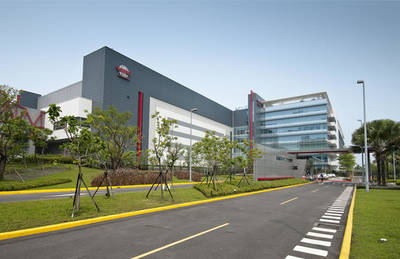
Taiwan's TSMC to build $16bn advanced chip facility
"Contract chipmaker Taiwan Semiconductor Manufacturing Co., which controls a leading 55% share of the global market, said on Wednesday it plans to build a $500 billion New Taiwan dollar ($15.7 billion) facility in Taiwan that would churn out the world's most advanced chips. "We're asking the government to help us find a plot that is large enough and has convenient access so we can build an advanced chip plant to manufacture 5-nanometer and 3nm chips," TSMC spokesperson Elizabeth Sun told the Nikkei Asian Review. The smaller the nanometer size, the more advanced the chip -- but also the more challenging to develop. Apple, for example, uses TSMC's 16nm process technology for the core processor chips packed in its latest iPhone 7 handsets. The Taiwanese company is looking to produce 10nm chips beginning early 2017." [...]
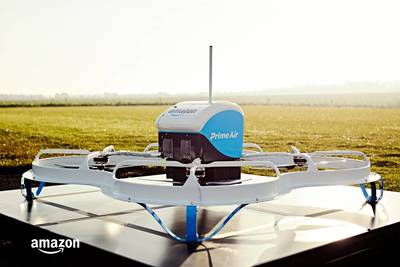
Amazon Conducts First Commercial Drone Delivery
"Amazon.com Inc.’s drone delivery program has liftoff—from a rural corner of England. Amazon last week made its first customer delivery by drone, carrying a package containing popcorn and a Fire TV video-streaming device several miles to a two-story farmhouse near Cambridge, U.K., in 13 minutes. A video the company released Wednesday shows a track the drone used to launch, a platform from which employees monitored takeoff, and a landing pad on the customer’s lawn. The delivery marks the start of operations for Amazon’s drone program after three years of skepticism and regulatory hurdles. Prime Air, as the initiative is known, aims to get packages to customers within 30 minutes." [...]
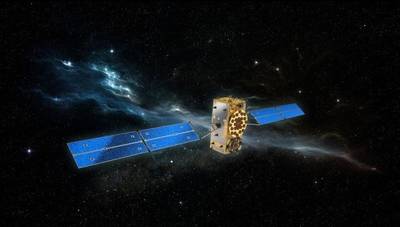
Galileo begins serving the globe
"Europe’s own Galileo satellite navigation system has begun operating, with the satellites in space delivering positioning, navigation and timing information to users around the globe. Today, the European Commission, owner of the system, formally announced the start of Galileo Initial Services, the first step towards full operational capability. Further launches will continue to build the satellite constellation, which will gradually improve the system performance and availability worldwide. ESA has overseen the design and deployment of Galileo on behalf of the Commission, with system operations and service provision due to be entrusted to the European Global Navigation Satellite System Agency next year." [...]
Outras Notícias
- New supercomputer will unite x86, Power9 and ARM chips
- Ikea introduces its first 3D knitted furniture
- Meet the new MKRZERO, the power of the ZERO in a smaller board!
- Qualcomm Begins Commercial Sampling of World’s First 10nm Server Processor and Reshapes the Future of Datacenter Computing
Ciência e Tecnologia ^

Researchers Develop Way To "Fingerprint" the Brain
"Using a new imaging technique, researchers have developed a way to "fingerprint" the human brain, confirming what scientists have always thought to be true: the structural connections in the brain are unique to each individual person. The Carnegie Mellon University-led team used diffusion MRI to map the brain’s structural connections and found that each person’s connections are so unique that they could identify a person based on this brain "fingerprint" with nearly perfect accuracy. Published in PLOS Computational Biology, the results also show that the brain’s distinctiveness changes over time, which could help researchers determine how factors such as disease, the environment and different experiences impact the brain. The new, non-invasive diffusion MRI approach captures the brain’s connections at a much closer level than ever before. For example, conventional approaches obtain a single estimate of the integrity of a single structural connection, or a white matter fiber. The new technique measures the integrity along each segment of the brain’s biological wires, making it much more sensitive to unique patterns." [...]

A Conscious Coupling of Magnetic and Electric Materials
"Scientists have successfully paired ferroelectric and ferrimagnetic materials so that their alignment can be controlled with a small electric field at near room temperatures, an achievement that could open doors to ultra low-power microprocessors, storage devices and next-generation electronics. The work, co-led by researchers at the Department of Energy’s Lawrence Berkeley National Laboratory (Berkeley Lab) and Cornell University, is described in a study to be published Sept. 22 in the journal Nature. The researchers engineered thin, atomically precise films of hexagonal lutetium iron oxide (LuFeO3), a material known to be a robust ferroelectric, but not strongly magnetic. Lutetium iron oxide consists of alternating single monolayers of lutetium oxide and single monolayers of iron oxide, and differs from a strong ferrimagnetic oxide that consists of alternating monolayers of lutetium oxide with double monolayers of iron oxide (LuFe2O4). The researchers found that by carefully adding one extra monolayer of iron oxide to every 10 atomic repeats of the single-single monolayer pattern, they could dramatically change the material’s properties and produce a strongly ferrimagnetic layer near room temperature. They then tested the new material to show that the ferrimagnetic atoms followed the alignment of their ferroelectric neighbors when switched by an electric field." [...]
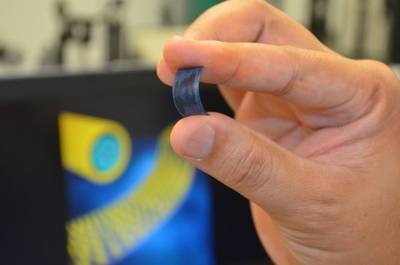
A Phone That Charges in Seconds? UCF Scientists Bring it Closer to Reality
"A team of UCF scientists has developed a new process for creating flexible supercapacitors that can store more energy and be recharged more than 30,000 times without degrading. The novel method from the University of Central Florida’s NanoScience Technology Center could eventually revolutionize technology as varied as mobile phones and electric vehicles." [...]
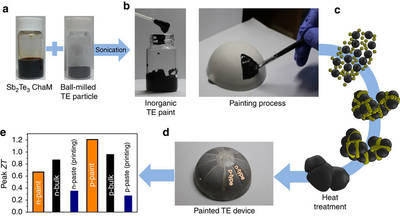
UNIST Engineers Thermoelectric Material in Paintable Liquid Form
"A new study, led by Professor Jae Sung Son of Materials Science and Engineering at UNIST has succeeded in developing a new technique that can be used to turn industrial waste heat into electricity for vehicles and other applications. In their study, the team presented a new type of high-performance thermoelectric (TE) materials that possess liquid-like properties. These newly developed materials are both shape-engineerable and geometrically compatible in that they can be directly brush-painted on almost any surface. Scientists hope that their findings, described in the prestigious journal Nature Communications this week, will pave the way to designing materials and devices that can be easily transferred to other applications." [...]
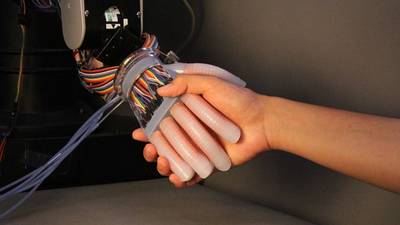
Optical tech gives prosthesis a more human-like sense of touch
""Soft" and "gentle" are two words not often used to describe the grasp of a robot, but thanks to the work of a team of researchers at Cornell University, future androids may well have an especially delicate touch. Using extra-sensitive optical detectors built into a soft prosthetic hand, the researchers have demonstrated a prototype that is able to tell by touch whether fruit is ripe, or to modify the pressure exerted on a material simply in response to the way it feels. The prototype made use of a combination of LEDs and photosensors incorporated in bendable tubes (known as elastomeric optical waveguides) and used as detectors of curvature, elongation, and force. These were then embedded in a stretchable, soft artificial hand, allowing the researchers in the Organic Robotics Lab at Cornell to use these devices to electronically register a large range of feedback and control the hand accordingly." [...]

Quantum computers ditch all the lasers for easier engineering
"They will be the ultimate multitaskers – but quantum computers might take a bit of juggling to operate. Now, a team has simplified their inner workings. Computers that take advantage of quantum laws allowing particles to exist in multiple states at the same time promise to run millions of calculations at once. One of the candidate technologies involves ion traps, which hold and manipulate charged particles, called ions, to encode information. But to make a processor that works faster than a classical computer would require millions of such traps, each controlled with its own precisely aligned laser – making it extremely complicated. Now, Winfried Hensinger at the University of Sussex in the UK and his colleagues have replaced the millions of lasers with some static magnets and a handful of electromagnetic fields. “Our invention has led to a radical simplification of the engineering required, which means we are now able to construct a large-scale device,” he says." [...]

Meet the World’s First Completely Soft Robot
"The “octobot” is a squishy little robot that fits in the palm of your hand and looks like something in a goody bag from a child’s birthday party. But despite its quirky name and diminutive size, this bot represents an astonishing advance in robotics. According to the Harvard researchers who created it, it’s the first soft robot that is completely self-contained. It has no hard electronic components—no batteries or computer chips—and moves without being tethered to a computer. The octobot is basically a pneumatic tube with a very cute exterior. To make it move, hydrogen peroxide—much more concentrated than the kind in your medicine cabinet—is pumped into two reservoirs inside the middle of the octobot’s body. Pressure pushes the liquid through tubes inside the body, where it eventually hits a line of platinum, catalyzing a reaction that produces a gas. From there, the gas expands and moves through a tiny chip known as a microfluidic controller. It alternately directs the gas down one half of the octobot’s tentacles at a time." [...]

Further Improvement of Qubit Lifetime for Quantum Computers
"Quantum computers could one day achieve significantly higher computing speeds than conventional digital computers in performing certain types of tasks. Superconducting circuits belong to the most promising candidates for implementing quantum bits, known as qubits, with which quantum computers can store and process information. The high error rates associated with previously available qubits have up to now limited the size and efficiency of quantum computers. Dr. Gianluigi Catelani of the Peter Grünberg Institute (PGI-2) in Jülich, together with his colleagues has now found a way to prolong the time in which the superconducting circuits are able to store a "0" or a "1" without errors. Beside Catelani, the team comprises researchers working in the USA (Massachusetts Institute of Technology, Lincoln Laboratory, and the University of California, Berkeley), Japan (RIKEN), and Sweden (Chalmers University of Technology). When superconducting materials are cooled below a material-specific critical temperature, electrons come together to form pairs; then current can flow without resistance. However, so far it has not been possible to build superconducting circuits in which all electrons bundle together. Single electrons remain unpaired and are unable to flow without resistance. Due to these so-called quasiparticles, energy is lost and this limits the length of time that the circuits can store data." [...]

Optical addressing method for full-color 3D display
"In volumetric displays, 3D images are rendered directly onto a physical volumetric space.1–3 These images can then be viewed by observers without the need for any additional devices. The application space for displays such as these includes 3D visualization for medical applications, human-computer interactions, architectural design, entertainment, and advertising. Indeed, some applications based on unique 3D volumetric-display architectures have already been proposed. Controlling volume elements (voxels) that are arranged in a 3D layout in the same manner by which pixels are controlled in conventional 2D displays presents a challenge, however. For example, the use of LEDs as voxels6 necessitates the presence of electrical wiring, which deteriorates the spatial resolution and induces occlusion in the displayed images. There exist a number of approaches to developing optically controlled volumetric displays that are capable of rendering 3D images without the need for wiring.7–12 Most of these approaches involve focusing a high-power laser beam at an arbitrary point in the volume, thereby inducing visible physical phenomena (e.g., plasma emission or photoluminescence) to produce numerous areas of light that together form a 3D image. In such approaches, three primary-color fluorescent materials (i.e., red, green, and blue) are placed at different positions relative to one another to achieve a full-color image. As such, these display devices require complicated structures (e.g., a stack of multiple thin layers)." [...]

Passive Components at the Performance Limit
"Many power applications place particularly high demands on the components they use, especially passive components. When it comes to selecting a resistor, this applies not only to the resistance value, but also to the upper power limit, while capacitors and inductors must be capable, above all, of storing energy efficiently. In this article, we present new high-performance models that meet these requirements." [...]
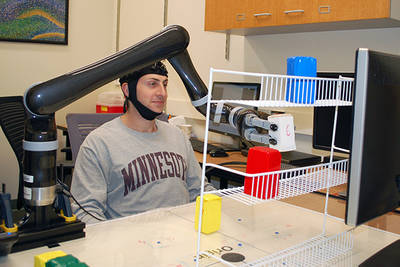
UMN research shows people can control robotic arm with their minds
"Researchers at the University of Minnesota have made a major breakthrough that allows people to control a robotic arm using only their minds. The research has the potential to help millions of people who are paralyzed or have neurodegenerative diseases." [...]
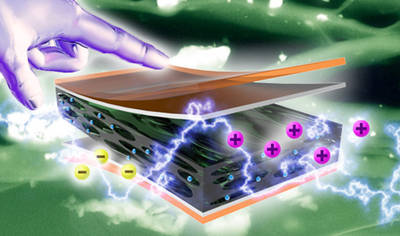
Flexible device captures energy from human motion
"The day of charging cellphones with finger swipes and powering Bluetooth headsets simply by walking is now much closer. Michigan State University engineering researchers have created a new way to harvest energy from human motion, using a film-like device that actually can be folded to create more power. With the low-cost device, known as a nanogenerator, the scientists successfully operated an LCD touch screen, a bank of 20 LED lights and a flexible keyboard, all with a simple touching or pressing motion and without the aid of a battery (click the respective links to see a short video of each demonstration). The groundbreaking findings, published in the journal Nano Energy, suggest “we’re on the path toward wearable devices powered by human motion,” said Nelson Sepulveda, associate professor of electrical and computer engineering and lead investigator of the project." [...]
Documentação ^
A documentação é parte essencial do processo de aprendizagem e a Internet além de artigos interessantes de explorar também tem alguma documentação em formato PDF interessante de ler. Todos os links aqui apresentados são para conteúdo disponibilizado livremente pelo editor do livro.
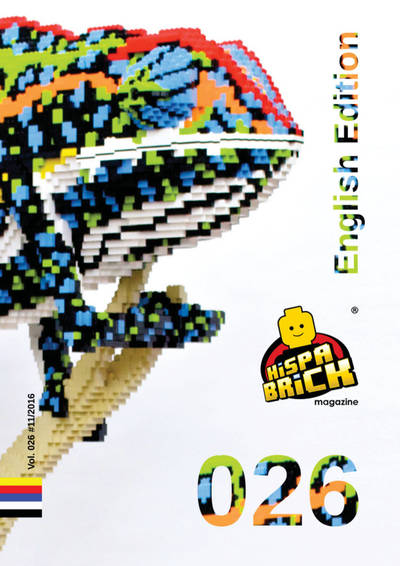
HispaBrick Magazine 026
"This issue includes interviews with Chris McVeigh and Sean Kenney, plus an in-depth look at steampunk LEGO. The team also reviews the new Beatles Yellow Submarine and Caterham Seven." [...]
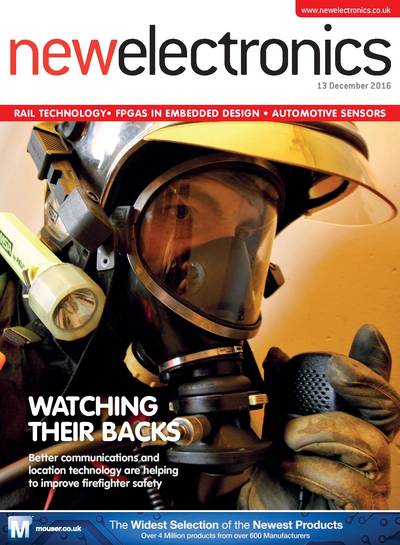
newelectronics 13 Dezembro 2016
"New Electronics is a fortnightly magazine focusing on technological innovation, news and the latest developments in the electronics sector. Downloadable as a digital page turner or pdf file, or offered as a hard copy, the New Electronics magazine is available in a format to suit you." [...]
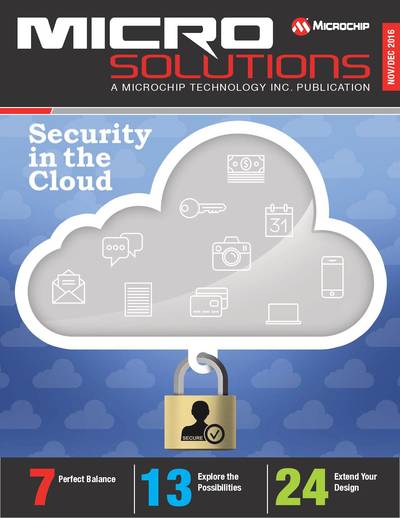
MicroSolutions November/December 2016
"MicroSolutions is Microchip’s bi-monthly digital magazine, delivering the latest information to give you a competitive edge and help you meet your design goals. In each issue, you’ll get an update on our new products and development tools, find design articles on a wide range of topics and learn about some innovative ways Microchip devices are being used by developers of a variety of applications. " [...]
Modelos 3D ^
Com a disponibilidade de ferramentas que permitem dar azo a nossa imaginação na criação de peças 3D e espaços como o thingiverse para as publicar, esta rubrica apresenta alguns modelos selecionados que poderão ser úteis.
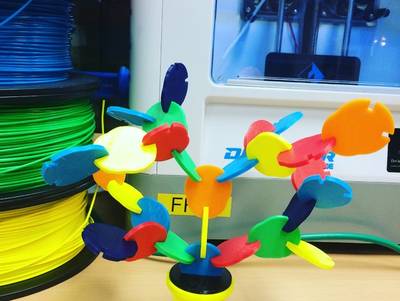
Colorfull tree puzzel
"I found out that we have a lot of colorored filament at school so I decided to start a project to be able to use them. This morning I saw a picture and I felt that this would be perfect." [...]

Customizable Tool Maker's Clamps
"This is a customizable tool maker's clamp. This video gave me the idea for making these: https://www.youtube.com/watch?v=1tRgONkbEdM Dimensions can be altered to suit your needs. Use the Customizer app to alter the clamp dimensions. Shown are two versions of the clamps. One version was printed to use 1/4"-20 threaded rod, while the 2nd version uses M3 screws. Required hardware: 2x threaded rod pieces or screws; 2x nuts to match threaded rod;Loctite to adhere nut to threaded rod." [...]
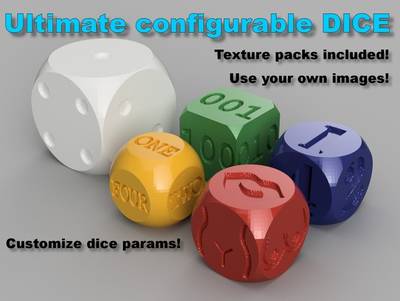
Ultimate configurable dice
"Bored by normal dices...? This design is for you! With ultimate configurable DICE you can easily create your own dice, putting your custom engravings on every six faces! Moreover you can select the dice size, the roundness you want and the engraving depth, to create a unique dice that no one owns! All this without leaving Thingiverse, nothing more easy!!! No more boring dices in your board games! Amaze your friends next time you'll play something that requires one or more dices!" [...]
Projetos Maker ^
Diversos Projetos interessantes.

Arduino Data Glasses for My Multimeter
"Trying to build a cheap Arduino Data Glasses for everybody. Why? I just wanted one. It's working, and now it can even help to avoid accidents. From the first idea to the working prototype, it took 4 Month. The challenge was, that It should be constructed out of common materials that can be found easily. The project is more about how to build the optical system for this HMD. One thing is clear, you can not just place a screen in front of your eyes, because it will not be possible for them to focus it. In the logs you can see from the first tests to what I have now. The optical design was the most difficult part, but I think I found a solution for this. The costs of the prototype amounted to +-70Euros." [...]
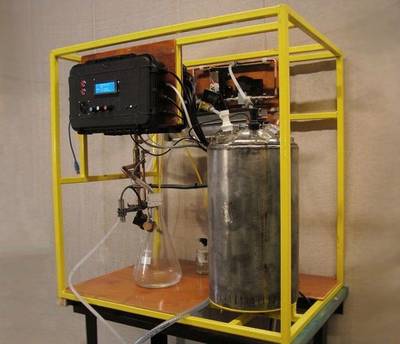
The NanoStillery™ - Automated Whiskey Distillery
"Historically, in Europe at least, it used to be very common for enterprising folk to travel around the land with their distillation equipment strapped to the sides of their donkeys providing a valuable service for owners of orchards and fruit bushes who wanted the produce turned into alcohol rather than having it wasted or eaten by birds and rats. In modern times, due to the advances of science, the equipment necessary for the process is much more sophisticated, but could, in theory, still be strapped to the back of a donkey. It's not an old wives tale - The process of distillation used to be rather dangerous, often involving the lethal combination of naked flames, self intoxication and explosive alcohol vapours. Now, thankfully, there is much more awareness of sensible drinking and the potential dangers of industrial processes. For me, the challenges are to automate the machine and make it as safe as reasonably possible, giving us lots of scope for using all kinds of weird and wonderful gadgets and sensors to monitor the process and minimise the risk of explosion." [...]
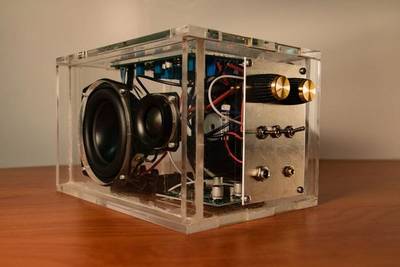
TPA3118 Amplifier and Speaker
"After using a TPA3118 amplifier module for a while, I thought it would be fun to design my own PCB with the popular TPA311x series of amplifier chips as my first major electronics project. But why stop there? I ended up throwing on a Bluetooth module, a crossover, a bass booster and designing a portable speaker to use this amplifier in. The speaker box features the Dayton Audio ND91-8 full range, ND20FB-4 tweeter, and the Peerless 830878 Passive Radiator. This project has been a huge opportunity to learn about circuitry, speaker design, and PCB layout. There was a very involved design process that is documented in a fair amount of technical detail in this Instructable. I hope sharing my experiences will help anyone who wants to embark on their own exciting journey of audio circuit design!" [...]
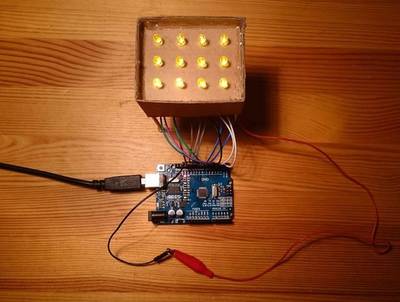
Simple DIY 3x4 LED display for Arduino MEGA / Uno / Nano
"In this Instructable I'll show you how to make a small 3x4 LED 'display' for an Arduino with a minimum of 12 pins (in this case I used an Arduino Uno). One reason for me to build this was to make a small display by just using the Arduino without needing an extra microcontroller - I just wanted to build something with with basic components. I know that I could do this better but it was my first own Arduino project (before that I just re-build other projects and copied the codes)." [...]
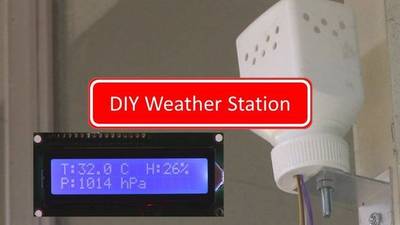
DIY Weather Station using arduino, DHT11 & BMP180 sensors
"Have you ever looked at those weather stations in your local retail catalogues and wish you had one but couldn't justify the expense ? Well, using a few components and a little tinkering you can build one for yourself, maybe even cheaper than the one at the shops. A weather station monitors local weather an can have many sensor to monitor temperature, humidity, air pressure, rainfall, wind speed, etc. Building one from scratch using a few cheap sensors and an arduino uno board (or compatible) can be quite simple, it just requires a little of your time once you have the components." [...]
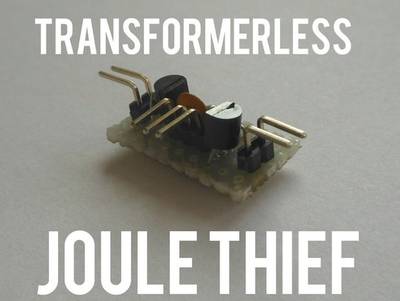
Transformerless Adjustable Joule Thief
"Did you have problems winding the toroidal transformer of a regular joule thief? If so then this instructable is for you! And if not it is also an interesting circuit to see. In this instructable I will show you how I made the simplest joule thief I know of with only an inductor!" [...]
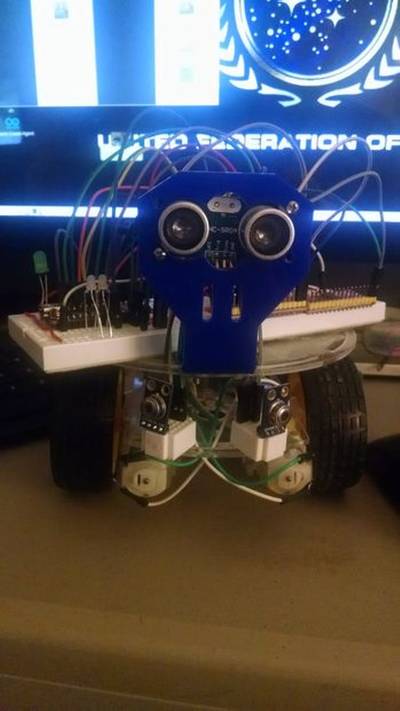
Snake Vision Robot using two MLX90614 No Contact Temperature Modules
"So, what I have is two MLX90614ESF Human Body Infrared Temperature Non-Contact Temperature sensors from IC Station. - These sensors use the I2C bus, what I am doing is using a multiplexer and switching between the two sensors pretty fast. These sensors are very sensitive to changes in temperature (Just like Snakes) The rapid change from one sensor to the other, could be like changing the of the lens snakes do. (Could be? well it sounds good anyway.) The sensors are set up at about a 45 degree angle from each other. If both sensors are the same the robot moves forward, if either of the sensors are different - the robot moves in the direction of the higher sensor reading (Moving toward the heat.) The robot build is pretty simple, so let's get into it." [...]
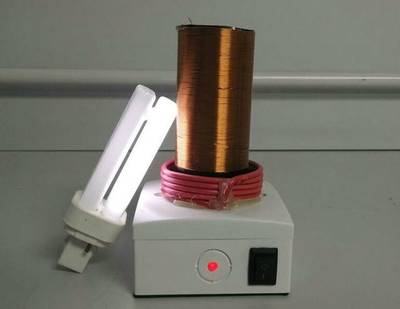
Make a Simple Portable Tesla Coil!
"I've made this Tesla Coil in reference of José Davēd's video: "DIY Tesla Slayer Exciter Coil Tutorial Mini How to Build Easy Circuit Explanation" I find that his circuit seems to work really well so I wrote this instructables and also redraw the circuit appropriately since his video did not have a appropriate circuit diagram. This project is a good starter for people who wants to know about tesla coils. Also a really cool object to place on your work desk!" [...]
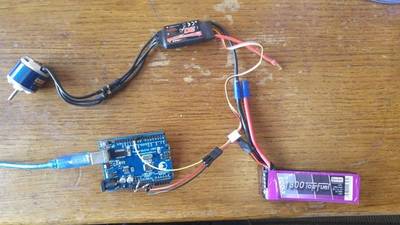
Programming Brushless Motor ESC without RF transmitter
"This instructable is on programming ESC controllers without RF transmitters or ESC programmers. I know that there are already quite a few of them around (such as this), but for my particular ESC their method did not work out too well out of the box, although my solution is basically a small variation on those. I will also cover the basics of how to interface an Arduino and an ESC." [...]
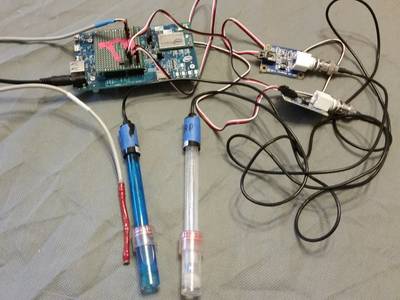
Aquaponic system monitor
"This project started out as a swimming pool monitoring system that was re-purposed to monitor an aquaponic system. It measures the water temperature, PH, and Chlorine levels in the water. The output is displayed on a web page. If any of the readings exceed set limits it sends a text to notify you that the situation needs looking into. The system runs on the Intel Edison Arduino board with a custom shield that simply makes connects to the sensors. The hardware has the capability of being powered by a 12V solar panel and backup battery that was used in the original swimming pool application but that isn’t used in the aquaponic application." [...]

LM386 tube amp
"I recently built the Bike Tyre Speaker and it really needed a little LM386 mono amp to boost the sound, as I wanted to 'Play It Loud'! My fascination with electronics started from dissecting old electrical equipment just to see what was inside... ...beauty and intrigue... ...what are those bits... ...I started to learn how to put my own electronics together, building a LM386 amp as my second electronics project. It really is a great little circuit for beginners to try. For this project I wanted to capture some of that beauty within and what better than the vacuum tube as an embodiment of seeing the 'working' inside... ...the glorification of the humble into an aesthetic beauty." [...]
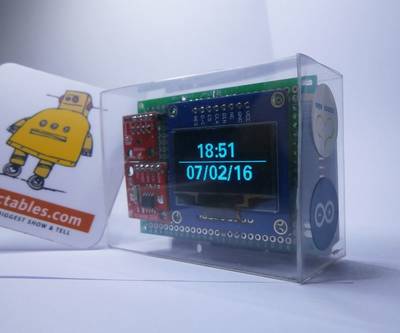
ThermoClock: An OpenSource Arduino UNO OLED Clock That Also Measures Temperature
"Today I am going to show you how to make An OpenSource Arduino UNO OLED Clock That Also Measures Temperature. This project is an OpenSource and it's open to everyone. It doesn't require any special engineer skills, and will take you less than couple of hours once you have all the parts you need. This clock will not only show you exact time and date but also it will show you the ambient temperature in both Fahrenheit and Celsius, with accuracy of 0.5°C (-25°C to +85°C) and with resolution of 0.0625°C. The pages are changing on every 10 seconds, but you can change that. The OLED we will use in this project is 1.3″ inch in size,monochrome blue in color, features 132×64 pixels and uses the SPI Bus. The temperature sensor we will use is TMP102, it's very small on size, low on power and uses the I2C Bus to communicate with our Arduino. And the DS1307 real time clock module uses the I2C bus so we will only need 2 pins to retrieve the date and time and display the results on the OLED display. We will use the u8glib library to communicate with our display. This library has many available parameters with it you can display numbers, letters, bitmaps and other symbols on OLEDs and graphic LCDs also it works for E-ink displays as well as other libraries." [...]
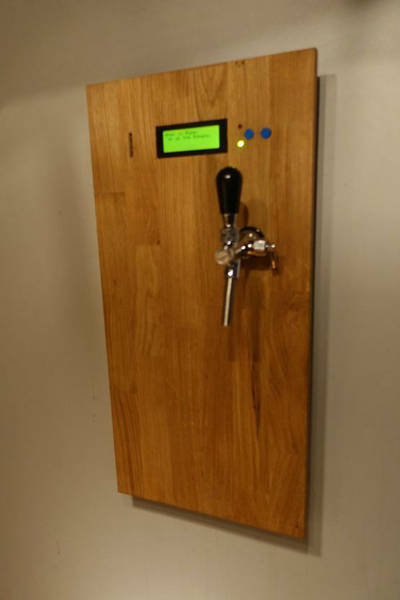
Arduino controlled Beermachine/ dispenser
"Hello world, a few weeks ago I decided to upgrade my homebrewing setup from bottling to kegging. In this process, I decided I wanted to make the dispenser automated. Also with a payment system. The intention of the payment system was not to earn money, but just as a challenge to myself. In the end, it turned out working very nicely. At first I wanted to make the whole system mechanical, because I study mechanical engineering, and have no experience with programming. I spent some days trying to figure out how to make the system all mechanical, but I didn’t quite figure out how. Then one day I decided to take a more electrical approach. As I currently have no subjects in programing and basically know nothing about any programming, I went to the library at my school and borrowed a book about programming Arduino, and a book about programing in C++. As I look back I think the book about C++ might have been an overkill. The same day I went to the online Arduino store and bought a starter kit. I also went to eBay and bought a lot of stuff that I might need. A list of what I used in this instructable will follow below. So, if you have no experience with programing, and want to learn in the prosses, I highly encourage you to make something similar, and learn in the prosses. I spent about 2 months from start to finish making this. And I have learned a lot!. At first I found the programing very frustrating, and hard. But now I feel like I understand at least something. But still I find it hard. And the coding provided in this instructable is not top notch. But the code works, and that is the most important if you ask me." [...]
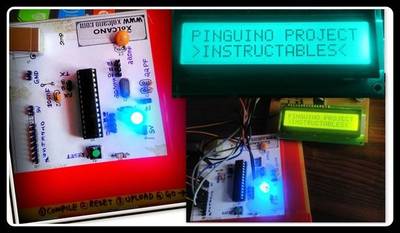
Pinguino Project (a PIC microcontroller based Arduino #No Programmer Required)
"Hey Guys i am Back after 2 months with Awesome Project,This is a Complete tutorial to make PIC Microcontroller based Arduino ,which can run Arduino Programs on PIC18F4550 or PIC18F2550 Microcontroller , one advantage on this microcontroller is ,it does'nt require any External Programmers, Since it has inbuilt USB support .so guys lets get started" [...]

Reducing Arduino Power Consumption
"When it comes to portable electronics, one of the most important features is how to maximize the battery life. The ATmega328P, used on popular boards like the SparkFun RedBoard, Arduino Uno, and Pro Mini are actually quite power hungry. The RedBoard and Arduino Uno, draw around 15mA minimum, which doesn’t sound like much but as you’ll see in this guide, we can drastically bring that down with just a few tricks. In this guide we’ll see if we can reduce the supply current to less than 10uA with a couple hardware and software tricks." [...]

Arduino - Obstacle Avoiding Robot (with L293D)
"Dual H-Bridge Motor Driver for DC or Steppers - 600mA - L293D. This is a very useful chip. It can actually control one motor independently. We will use in its entirety the chip in this tutorial. Pins on the right hand side of the chip are for controlling a one motor. Pins on the left hand side of the chip are for controlling second motor. You can run four solenoids, two DC motors or one bi-polar or uni-polar stepper with up to 600mA per channel using the L293D." [...]

A amazing kitchen Hack │ Upgrading a vegetable chopper manual to automatic
"This time I bring something which you all go through in day to day life. yes a manual vegetable chopper. your or you mom those who use chopper got very frustrated by operating it manually so what i did, joint a high torque gear DC motor with the shaft of the machine and let motor to do rest of work just power up the motor thats it you got chopped all of your vegetable instantly" [...]

AT89SXX Development Board
"Our AT89Sxx Development Board provides a very simple and cost effective platform for prototyping solution. The compact design provides connection to all the pins of the microcontroller for the user." [...]
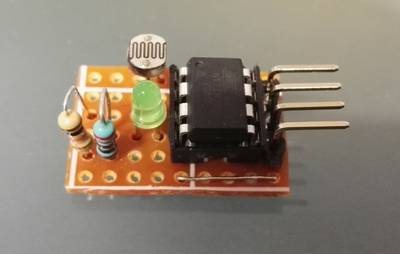
ATtiny85 Light Sensor – I2C slave device
"I love AVR ATtinyx5 series microcontrollers. They are cheap, easy to use, they can be programmed just like Arduinos and comparing to their size they offer great features. For example, they can be used as remote analog to digital converters connected to master device using I2C bus. Background: few year ago I've build a weather station based on Raspberry Pi. It collects various data and displays them on dedicated web page and Android app. Every few months I try to add a new sensor to it. Last time it was a daylight sensor. Raspberry Pi does not offer ADC inputs and I has few ATtiny85 on hand that time. One to another, few hours later: photoresistor based daylight meter sensor connected via I2C bus." [...]

Homebridge MCUIOT / An ESP8266 based sensor platform
"In today's instructable, we will be making low cost temperature, humidity and moisture sensor based on either the AOSONG AM2302/DHT22 or BME280 temperature/humidity sensor, YL-69 moisture sensor and the ESP8266/Nodemcu platform. And for displaying the data, we will be using homebridge to integrate to Apple's HomeKit. This supports multiple devices and device discovery using mDNS, with minimal configuration required in Homebridge." [...]

Tutorial to Interface HX711 Balance Module with Load Cell
"This module uses 24 high-precision A / D converter. This chip is designed for high-precision electronic scale and design, has two analog input channels, programmable gain of 128 integrated amplifier. The input circuit can be configured to provide a bridge voltage electrical bridge (such as pressure, load) sensor model is an ideal high-precision, low-cost sampling front-end module." [...]
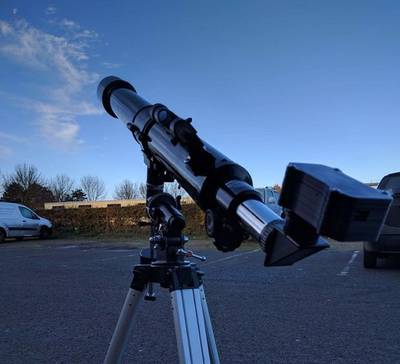
Astrophotography with the Raspberry Pi Zero
"I have made two other Raspberry Pi based camera projects before. This, my third camera idea, is my first Raspberry Pi Zero project. This is also my first go at Astrophotography! Spurred on by the recent 'Supermoon' I wanted to get my brother's old Celestron Firstscope 70 EQ back into service. Over the past 10 or so years the eyepieces have all gone missing but the telescope covers have remained in place keeping the dust out. In my useful electronics tub is a Pi Zero and a matching camera cable. Along with a LiPo, Powerboost 1000 and a camera module. A perfect coagulation of components, just ripe for the making....." [...]
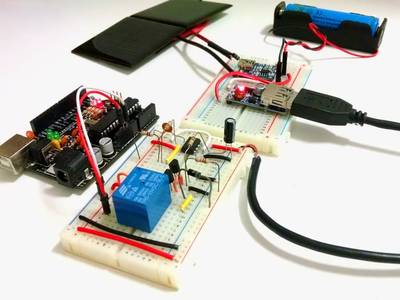
Solar Charged Battery Powered Arduino Uno
"This tutorial shows how to create a time switching battery powered solar charged circuit, which is used to power an Arduino Uno and some peripherals (sensors, communication modules, etc.). If you want to design a remote data logger, power supply is always a problem. Most of the times there is no power outlet available, and that forces you to use some batteries to power your circuit. But eventually your device will go out of batteries... and you don't want to go there and charge it, right? So a solar charging circuit was proposed to user free energy from the sun to charge the batteries and to power your beloved Arduino." [...]

DIY Arduino-Based Sous-Vide Machine
"Build your very own sous-vide machine and get perfectly cooked meals with high-precision temperature control. Grab your Arduino, a rice cooker, and a temperature sensor and let's get started. Are you a foodie or simply just enjoy eating a properly cooked meal? If the answer is yes, you need to have a sous-vide machine in your life. They are very easy to build and maintain and the whole project can be done in just a weekend. This project is mostly dedicated to meat lovers, but vegetarians could also make use of this device." [...]
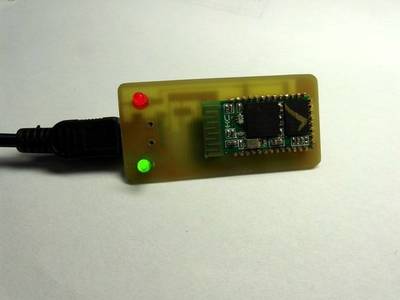
HC-05 bluetooth programmer
"To build this programmer you will need Parts: 1xFTDI232RL1xLP2985AIM 3.3 2x 0.1uF 1206 - ceramic capacitors2x 0R 12062x 0.1uF 0805 - ceramic capacitors4x 1k 0805 - resistors 2x 120R 0805- resistors 2x 3mm led for indication ( Green led - power, Red led - Bluetooth)1x USB mini-b socket Header pins." [...]
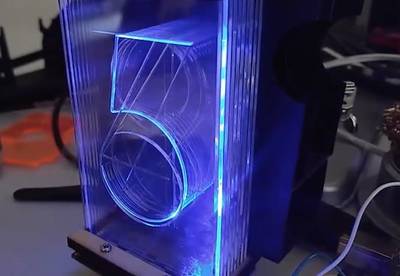
"Lixie", an LED alternative to the Nixie Tube
"I've always been a fan of the Nixie Tube. Beautiful typography, endearing glow, and very clever technology. But when commercial production stopped in the 1990s, prices for surplus Nixie Tubes began to rise. Smaller tubes like the IN-16 are still only about $3.50/piece, but bigger and more desirable tubes like the IN-18 can run up to $45/piece. If you wanted to make a 6-digit clock, it can cost up to $270 just for the tubes! And they're potentially dangerous. And they might "burn out" next week. And they need special switching circuitry. And they're old news. " [...]
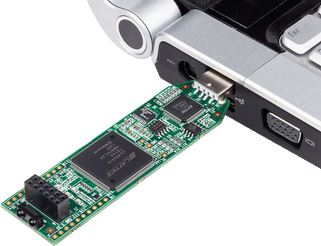
SUMP2 – 96 MSPS LOGIC ANALYZER FOR $22
"Black Mesa Labs has an ongoing mission to develop easy to use and fully capable open-source hardware and software tools that make engineering electronics easier. One such tool is this new low cost open-source logic analyzer called SUMP2 for people who otherwise work in the blind without an oscilloscope or logic analyzer on their bench top. BML’s 1st incarnation called SUMP1-RLE in 2014 was a 16bit FPGA based logic analyzer that performed real-time hardware compression and decompression. The decompressed data was streamed out over USB using the open SUMP protocol ( hence the name ), allowing it to be used with the excellent Java software from the original 2007 sump.org project. The SUMP1-RLE project was later enhanced from just 16 triggerable events to also include 2 DWORDs of “data” ( additional 64bits of non-triggering non-compressed signals ) and advanced triggering options. Including the data DWORDs made SUMP1 a useful tool for complex FPGA development debugging of internal FPGA event nodes and data paths. These new features required new custom software, written by BML in .NET for Windows. The software was functional, but graphically slow and was mostly used for trigger setup and then exporting captured data as VCD files into GTKwave for viewing." [...]
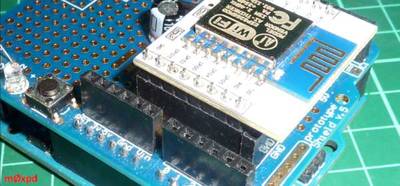
Homebrew WiFi Shield
"Having just finished development of the new m0xpd / Kanga ESP8266 - AD9834 board, I find myself with a few WiFi components knocking about on the bench - so I figured it would be fun to try to make a WiFi shield for an Arduino... Using an ESP8266 (in a module, such as an ESP-12) as a WiFi shield for an Arduino is a little like using the proverbial 'steam hammer to crack a nut' - but these modules are frighteningly cheap and I do want a WiFi shield (which are surprisingly expensive)." [...]
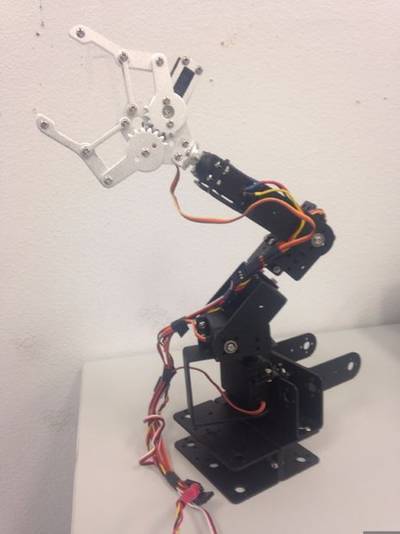
5 DOF Robotic Arm Kit With Code
"In this tutorial, we will create a robotic arm that will be controlled by a keyboard. This can be used to demonstrate a cool project to friends or something that can be used as part of a bigger project. The system was created using a Xilinx Zybo development board and the Vivado Design Suite." [...]
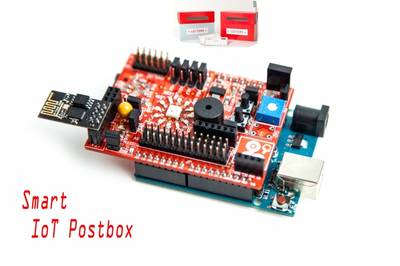
Smart IoT Postbox with the idIoTware Shield
"In this project, I am going to demonstrate how to build your own IoT aware Postbox with the help of the idIoTware shield in a few easy steps. This postbox alerts you about new envelopes dropped inside a postbox by the mailman. The LDR ( Light Dependent Resistor) on IdIoTWare shield is used as sensor to detect a letter being dropped into the letterbox. The on board WS2812 Led (addressable RGB LED) on IdIoTWare shield is continuously ON (WHITE Color) which acts as a light source, and reflects light onto the LDR. As soon as a letter is dropped into the postbox, there is an interruption in light - the light intensity on LDR changes due to reflection. The Arduino continuously monitors the change in the value of the LDR and when it notices a change in value, it sends an email. Here we are using IFTTT to send a pre configured email. " [...]
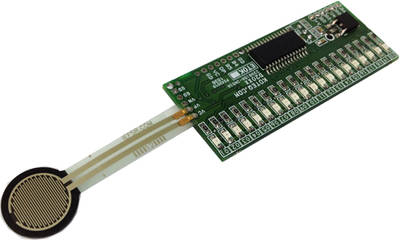
Flex Sensor to bargraph monitor using PIC16F886
"Tiny Bar-Graph display provide a Red color bright, easy to read display which is proportional to the force applied on FLEX sensor surface. This Bar-Graph has 20 segments in single color and display Force applied on FLEX sensor. The Barograph force monitor is based on PIC microcontroller with 10 Bit resolution ADC. This high performance measurement provides unique capabilities and can be used in various applications. Each LED output provided with Solder- jumper for output set point, which can be configured for output control, alarm, Relay. Force sensing resistors are polymer think film devices which exhibits a decrease in resistance with an increase in the force applied to the active surface. Its force sensitivity is optimized for use in human touch control of electronic devices." [...]
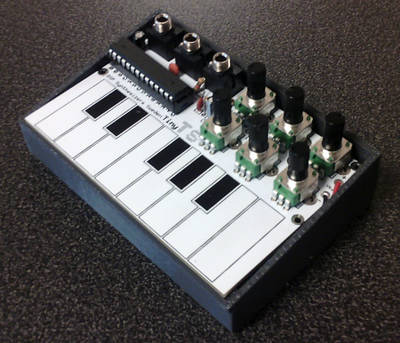
The TinyTS – DIY Synth
"The Tiny TS is a credit card sized (100x65mm) fully open-sourced synthesizer with a 1-octave capacitive touch keyboard. It has Audio/CV/Gate outputs and 6 synth parameter dials. The CV’s output 1V/oct and Gate from the keyboard." [...]

How to make a Music-Time Display
"For our project we will make digital stopwatch that displays the amount of time a song plays. Our device will display time (second, tenths of a seconds, hundredths of a seconds) using the 7 segment display. The user can chose from one of two songs. A switch will allow the user to start the song and once the song is over, reset the display to zero (and the song will reset to the beginning). The potentiometer will allow the user to select one of two song, Star Wars Theme Song (pot arrow pointing up) or Star Wars Imperial March (pot arrow pointing down). Similarly an LED will blink in unison to the song. For this we will use both a Arduino and FPGA board (Basys 3). We choose this gizmo because we really enjoyed the clock signal found in our FPGA and it gave us an opportunity to display our mad VHDL skills. This is similar to a car radio, that displays the timing for a song. The user will have the option of selecting one of three song. Then the Arduino will play the selected song. Once the song starts playing the 7-segment display will begin to count up, displaying seconds, tenths of a second, and hundreds of a second." [...]

A game for my nephew
"This is about an *uino game I made for my nephew Wes. It's his birthday this month and since a few years back I am building something for him myself. Two years ago it was a traffic light. Last year I made him a talking clock. (Sorry no instructable for that one, only a vid on my YT channel.) I'd like him to see what fun learning electronics and programming is. If he picks it up, his future will be a bit brighter, there are and will be many jobs for technical people. " [...]

Retrieving ST-Link/V2 Firmware from Update Utility
"The STM32F3DISCOVERY is a small circuit board with a great microcontroller. The ARM Cortex-M4 chip has 256 KB of flash memory, 48 KB of RAM, USB and more. The board has huge amounts of header pins connected to the microcontroller and has a gyroscope, accelerometer and compass on board. For the 11 USD that this board costs, you definitely get a lot of functionality. The board also has 2 USB ports, one which is connected directly to the microcontroller, and the other connected to the smaller microcontroller pictured above (STM32F1) and is used for programming and debugging the device. STMicroelectronics calls the programming solution ST-Link/V2. When used with the proper software, it works quite well. However Linux support was initially lacking, but texane and OpenOCD were able to create working drivers. My goal was to dump the firmware." [...]

IoT Decimal/Hexadecimal 8x8 LED Matrix Drawing Board
"This project is a follow-up project of my previous Instructable called IoT RPi LED Message Board. I am a facilitator for a local Girls Who Code club and I wanted a simple yet fun tool to teach students on how to convert from bitmap/binary to decimal and hexadecimal. Please follow Steps 1 and 2 on IoT RPi LED Message Board to configure RPi. We'll be using the same setup as my previous project except for the new ZeroMQ server code that uses a different max7219 function to draw pixels column by column (or row by row if you rotate the LED matrix 90 degree clockwise.)" [...]
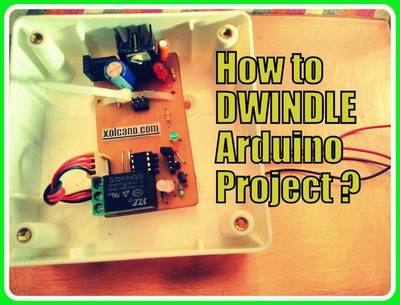
#DIY# A Complete Guide to Build Your own ATtiny85 Project PCB with Relay and Interfacing HC05 Bluetooth Module to it
"Sometimes we need to build a smaller circuit for our projects,but unfortunately, if we use Breadboard or Perforatedcopper board for project ,the size of the project will become larger , so to overcome this issue ,we must go for PCB but to build PCBs it take much time ,hence in thisInstructable I will show you how to design your PCB by using CD marker , which will overcome time and pain of Designing it in Computer software like Eagle,Diptrace,Fritzzing,KiCAD,Tina and also cost effective too." [...]
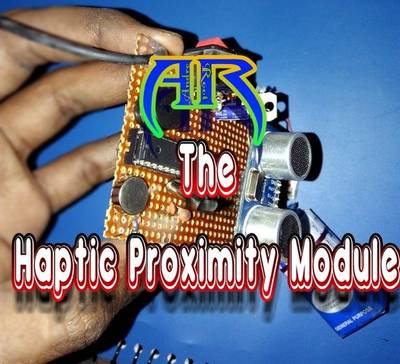
Haptic Proximity Module - Cheap and Easy
"God gifted sense of vision to the human being is an important aspect of our life. But there aresome unfortunate people who lack the ability of visualizing things.There are approximately 37 million people across the globe who are blind, over 15 million are from India. Even for the non-visually impaired the congestion of obstacles is sometimes problematic, it’s even worse for the visually impaired. People with visual disabilities are often dependent on external assistance which can be provided by humans, trained dogs, or special electronic devices as support systems for decision making. Existing devices are able to detect and recognize objects that emerge on the floor, but a considerable risk is also includes the objects that are at a sudden depth, or obstacles above waist level or stairs. Thus we were motivated to develop a smart device to overcome these limitations." [...]
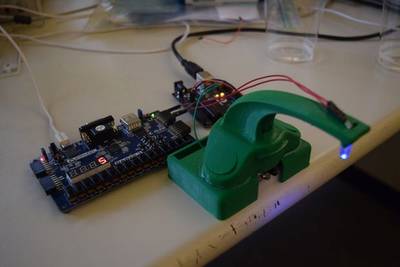
Automatic Faucet System with FPGA and IR Object Sensor
"We built a system that modifies an existing idea that is used extensively in public restrooms: faucet automation. We created an updated design that will lead to more efficient water use in faucets. We chose this idea because the existing sensor/timing system already in place is extremely ineffective at both conserving water and washing hands, not to mention frustrating to use. Our improvement on this idea includes a more effective timer and display, a sensor that will turn the water off if there are no hands sensed under the sink, and a manual override switch that takes precedence over the entire system as an option for filling bottles or buckets with no fear of the timer turning water off. This conserves more water than the existing model because it has 3 conditionals on whether or not the water is on or off, plus the timer display will provide a way for the user to see how long the water has been on. The previous model used one conditional: if hands were sensed under the faucet, a timer would start and only turn off after a preset short amount of time." [...]

FPGA Automated House Lights
"For this project we will use a BASYS3 Board by Diligent for the purpose of taking what is meant to be a learning tool and giving it a creative purpose. A common problem I've noticed across many households is energy waste via lights that remain unintentionally turned on. This FPGA Automated House Lights project serves to simulate a light control system within a house using 4 inputs and a timer. 3 switches control 6 lights and one switch acts as a "master toggle" which; upon activation, initiates a countdown to turn off the default lights such as the ones commonly found on a front porch or backyard." [...]
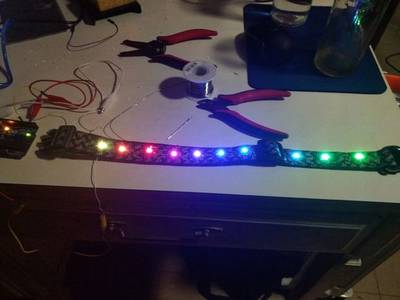
Mood Collar: Final Class Project
"The mood collar was a project for an Interactive Electronic's Class at college. The assignment was to design a wearable as a form of electronic art. Please read through the instructions first before, you set out to build one yourself." [...]
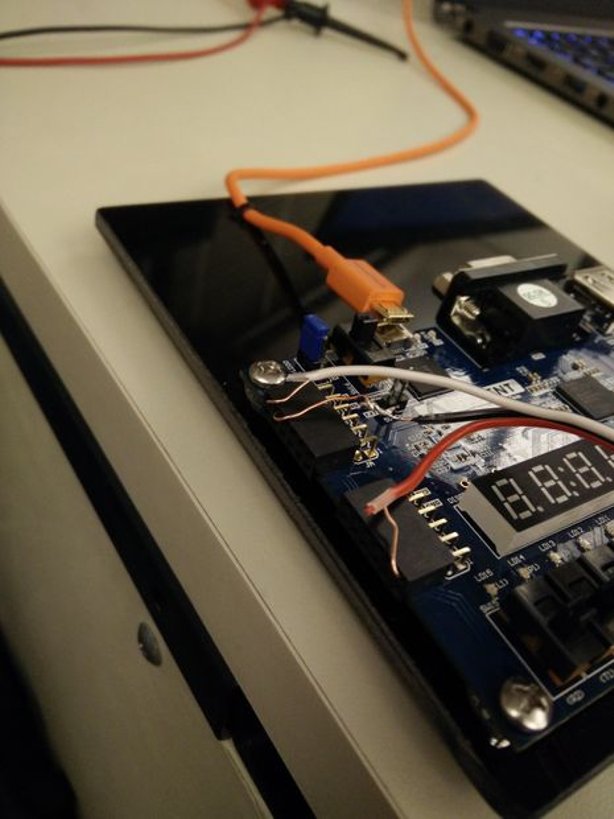
Basys3 Bicycle Odometer
"Wouldn’t it be cool if the government promoted environmental sustainability by offering rebates for distance biked? This would encourage people to bike rather than drive, which would decrease our carbon emissions. This was the idea behind our project. We imagined that we could create a bike odometer that would measure distance traveled, and then at the end of each month, the government could in return issue a cash rebate dependent upon distance traveled to encourage sustainability. For this project, we created a bike odometer using the Agilent Basys3 Board. Using a hall sensor and a magnet, the sensor detects each rotation of the bike wheel and then shows the distance traveled on the Basys seven-segment display. The magnet is attached to the wheel and every time the magnet passes the hall sensor it closes the gate in the hall sensor, making the voltage that it outputs equal to zero." [...]
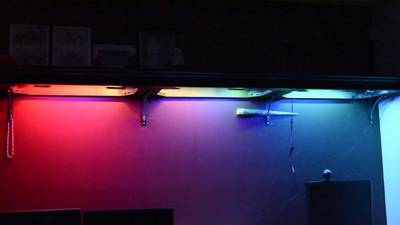
Shelf Accent Lighting with Arduino, Smartthings and LED Strips
"This instructable is based on my previous instructable http://www.instructables.com/id/Arduino-and-SmartThings-LED-Strip-Lighting/ . During the previous instructable I learned a lot and it had to change pretty substantially. The purpose of this instructable is to fix the mistakes I made and combine what I learned in order to finish the accent lighting for my spouse and daughter's desk shelf. We are going to completely start over in this instructable highlighting the differences between the previous, so please follow along step by step." [...]

Esquilo Air & HC-SR04 Ultrasonic Sensor Tutorial
"If you aren't familiar with it, the HC-SR04 is very commonly sold sensor for the IoT and maker markets and uses Sonar (like a Bat) to find distance to an object. It has a sender and a transmitter which sends out a small ultrasonic pulse which bounces off of an object and back to the sensor. Because of how this works please take into consideration that small objects and those that don't reflect sound (like cloth or soft fuzzy things) may not work well with this sensor. It works best with hard and reflective items like glass, metal and most plastics. If you search around you can find that several vendors sell the HC-SR04 sensors and if you price shop you can sometimes find them under $2 each, although watch out for shipping times and charges as many times the very inexpensive vendors ship from China instead of the US." [...]
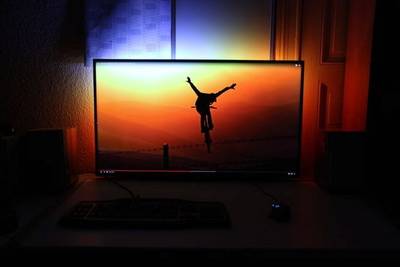
Cheap DIY Ambientlight using Arduino
"The Ambilight in this picture is completely DIY and uses some cheap RGB LEDs with integrated controllers and an Arduino. On the Software side, there is Ambibox running on the PC (Windows only) and the FastLED library on the Arduino! The Ambilight is totally DIY and easily bright enough so that no other light is needed. The screen is mounted to the wall and flushes with the table. (So no Ambilight at the bottom.)" [...]
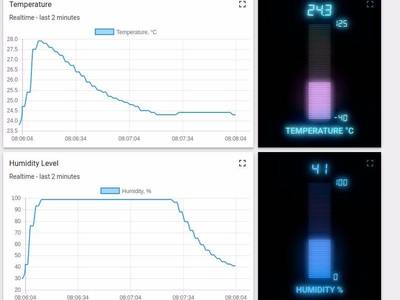
Temperature dashboard using Arduino UNO, ESP8266 and MQTT
"This sample application performs collection of temperature and humidity values produced by DHT22 sensor and further visualization on the real-time web dashboard. Collected data is pushed via MQTT to Thingsboard server for storage and visualization. Thingsboard is an open-source server-side platform that allows you to monitor and control IoT devices. It is free for both personal and commercial usage and you can deploy it anywhere. Once you complete this tutorial, you will see your sensor data on the following dashboard." [...]
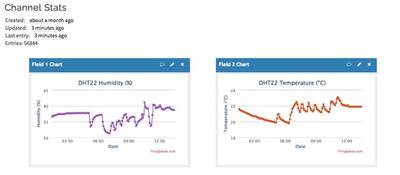
Raspberry Pi 2 IoT: Thingspeak & DHT22 Sensor
"This project uses a Raspberry Pi 2 to collect temperature and humidity data from a DHT22 sensor, which is then uploaded to the ThingSpeak Internet of Things platform to be displayed in real-time. This write-up is primarily intended to serve as documentation for the project, but may also be of use as a tutorial for others. It assumes a beginner skill level and that you are running the Raspberry Pi without a screen (referred to as a headless setup)." [...]
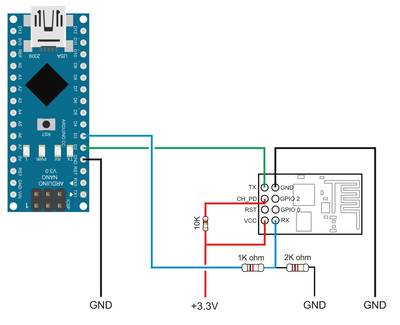
Arduino to ESP8266 By Serial Communication
"Following on from my last post, if you do not have a FTDI serial adaptor you can use an Arduino. Here is how to set up the Arduino to talk to the ESP8266. I an using a 5V Arduino Nano which of course is 5V. The Esp8266 is a 3.3v device and so I am using a voltage divider to bring the Arduinos 5V down to 3.3v. If you are using a 3.3v Arduino then you do not need the voltage divider." [...]
That's all Folks!


